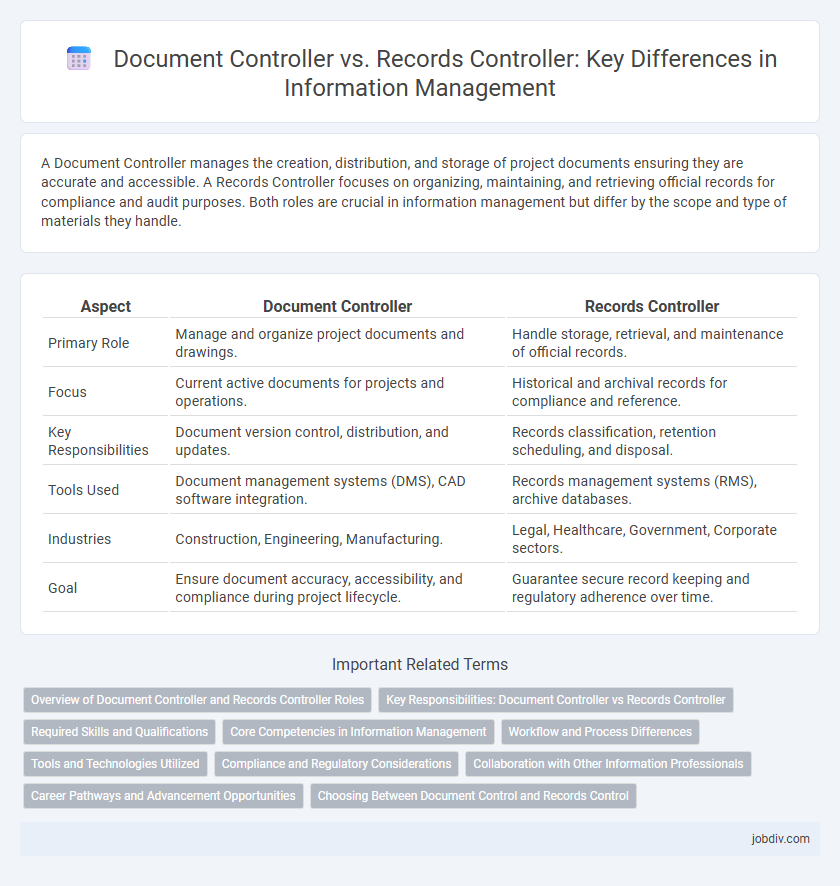A Document Controller manages the creation, distribution, and storage of project documents ensuring they are accurate and accessible. A Records Controller focuses on organizing, maintaining, and retrieving official records for compliance and audit purposes. Both roles are crucial in information management but differ by the scope and type of materials they handle.
Table of Comparison
| Aspect | Document Controller | Records Controller |
|---|---|---|
| Primary Role | Manage and organize project documents and drawings. | Handle storage, retrieval, and maintenance of official records. |
| Focus | Current active documents for projects and operations. | Historical and archival records for compliance and reference. |
| Key Responsibilities | Document version control, distribution, and updates. | Records classification, retention scheduling, and disposal. |
| Tools Used | Document management systems (DMS), CAD software integration. | Records management systems (RMS), archive databases. |
| Industries | Construction, Engineering, Manufacturing. | Legal, Healthcare, Government, Corporate sectors. |
| Goal | Ensure document accuracy, accessibility, and compliance during project lifecycle. | Guarantee secure record keeping and regulatory adherence over time. |
Overview of Document Controller and Records Controller Roles
Document Controllers manage the organization, storage, and distribution of project documents, ensuring version control and compliance with company standards. Records Controllers focus on maintaining the accuracy, retention, and retrieval of organizational records, supporting legal and regulatory requirements. Both roles are critical for efficient information management, with Document Controllers primarily handling active project documents and Records Controllers managing long-term archival materials.
Key Responsibilities: Document Controller vs Records Controller
A Document Controller manages the creation, distribution, and proper filing of project documents, ensuring compliance with company standards and facilitating easy access for team members. In contrast, a Records Controller oversees the lifecycle of records, focusing on their secure storage, retrieval, preservation, and eventual disposal according to regulatory requirements. Both roles are critical for maintaining an organized information management system but differ in scope, with Document Controllers emphasizing document workflow and Records Controllers prioritizing record retention and compliance.
Required Skills and Qualifications
Document Controllers require proficiency in document management software, attention to detail, and strong organizational skills to maintain accurate and accessible project documentation. Records Controllers need expertise in records lifecycle management, compliance with data protection regulations, and ability to classify, store, and retrieve physical or digital records efficiently. Both roles demand excellent communication skills, knowledge of industry-specific standards, and experience with version control and audit processes.
Core Competencies in Information Management
Document Controllers specialize in organizing, classifying, and maintaining project documents with skills in version control, distribution, and compliance auditing. Records Controllers focus on systematic archiving, retrieval, and secure disposition of records, emphasizing legal adherence, classification standards, and lifecycle management. Expertise in information management systems, metadata tagging, and regulatory frameworks are core competencies critical for both roles.
Workflow and Process Differences
Document controllers manage the creation, revision, and distribution of project documents to ensure accuracy and compliance with standards, using workflows that emphasize document version control and approval processes. Records controllers focus on the systematic organization, storage, retrieval, and retention of records, implementing classification schemes and retention schedules to maintain regulatory compliance and facilitate audits. The primary workflow difference lies in document controllers handling live document management with collaborative inputs, whereas records controllers manage finalized records for long-term preservation and access.
Tools and Technologies Utilized
Document Controllers primarily use Electronic Document Management Systems (EDMS) such as SharePoint, Documentum, and Aconex to organize, track, and manage documents efficiently. Records Controllers leverage Records Management software like OpenText, TRIM, and Laserfiche to ensure compliance with regulatory requirements and facilitate long-term data retention. Both roles often integrate cloud storage solutions and version control tools to enhance accessibility and maintain data integrity.
Compliance and Regulatory Considerations
Document Controllers manage the creation, revision, and distribution of company documents to ensure accuracy and accessibility, adhering to compliance standards such as ISO 9001. Records Controllers focus on the systematic archiving, retention, and disposal of records, ensuring regulatory compliance with data protection laws like GDPR and industry-specific requirements. Effective collaboration between Document and Records Controllers is essential to maintain audit readiness and minimize legal risks through proper documentation and record-keeping practices.
Collaboration with Other Information Professionals
Document Controllers maintain meticulous organization of project documents, enabling seamless collaboration with information managers, archivists, and compliance officers to ensure document accuracy and accessibility. Records Controllers specialize in managing long-term information retention and retrieval, working closely with information governance teams and digital asset managers to uphold regulatory compliance and data integrity. Both roles rely on effective communication and integration with IT specialists and data analysts to streamline workflows and optimize information lifecycle management.
Career Pathways and Advancement Opportunities
Document Controllers primarily manage and organize project files, ensuring accuracy and accessibility, with career advancement leading to roles such as Documentation Manager or Project Coordinator. In contrast, Records Controllers specialize in maintaining compliance and secure storage of organizational records, progressing toward positions like Records Manager or Compliance Specialist. Both careers offer pathways into broader information management and administrative leadership roles within various industries.
Choosing Between Document Control and Records Control
Choosing between document control and records control depends on the organization's needs for managing current and archived information. Document control focuses on managing active documents, ensuring version control, and facilitating workflow efficiency, while records control emphasizes the long-term storage, retention, and legal compliance of historical data. Effective information management requires aligning the choice with regulatory requirements, operational processes, and the lifecycle stage of the information.
Document Controller vs Records Controller Infographic

 jobdiv.com
jobdiv.com